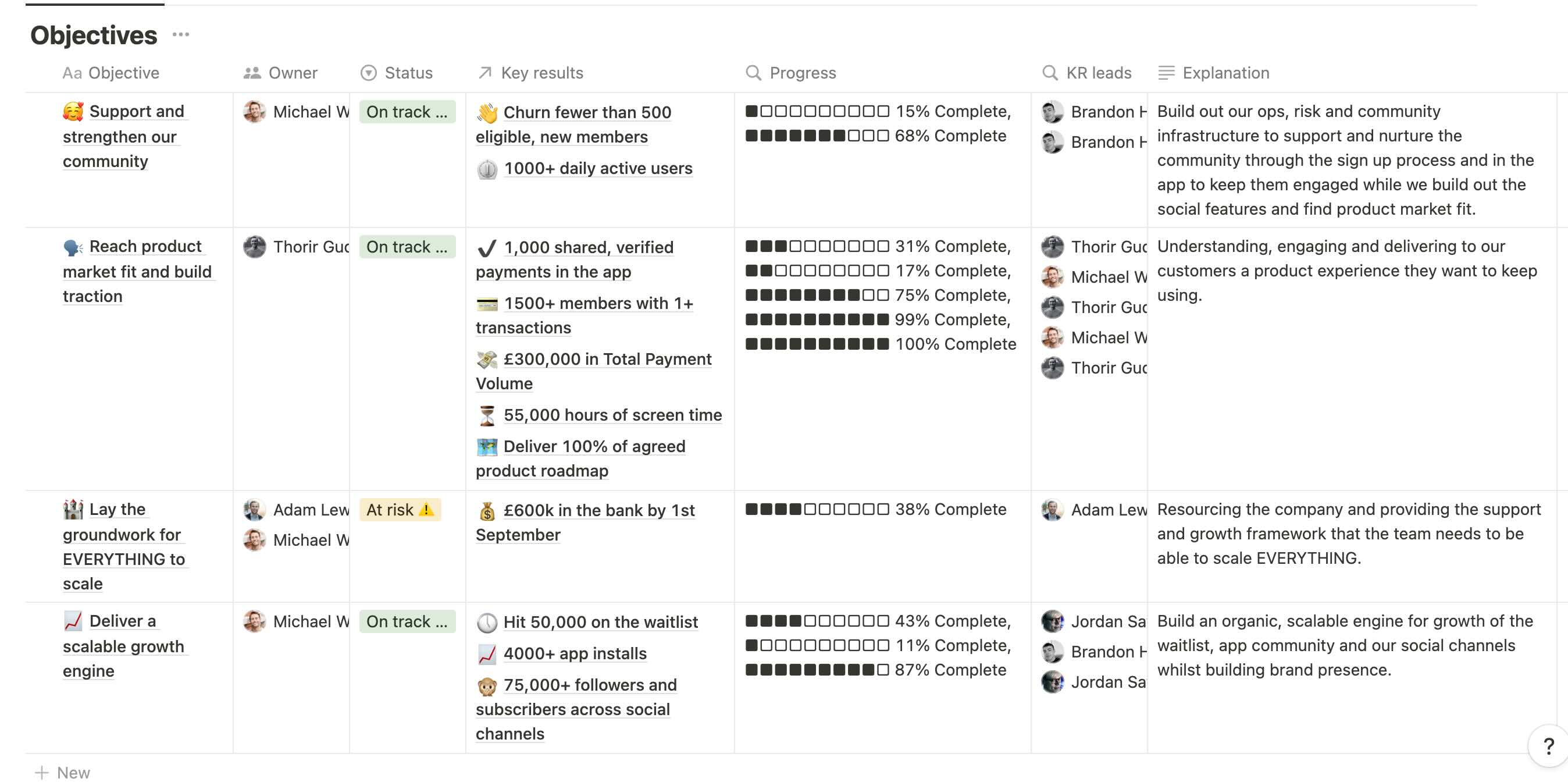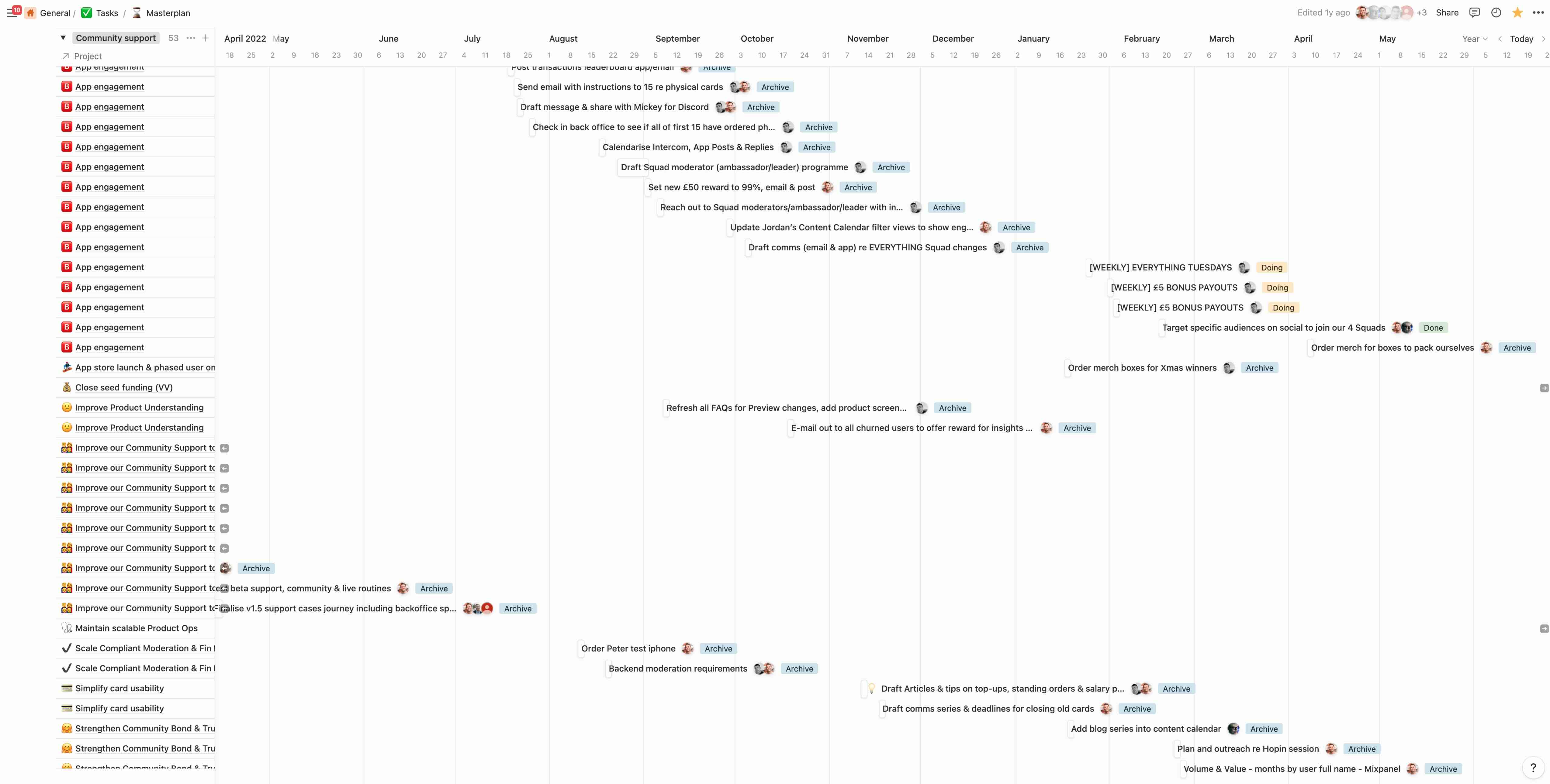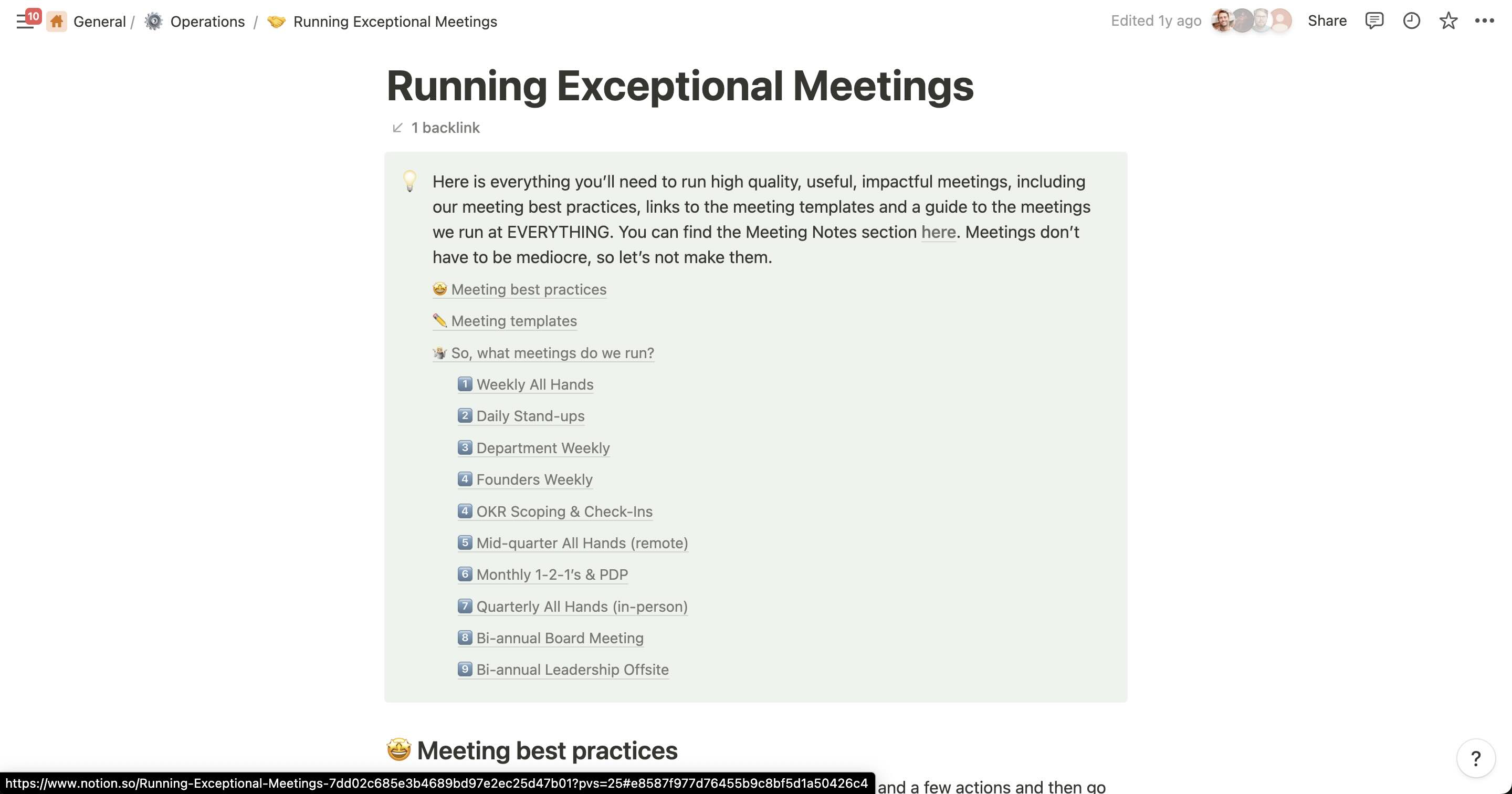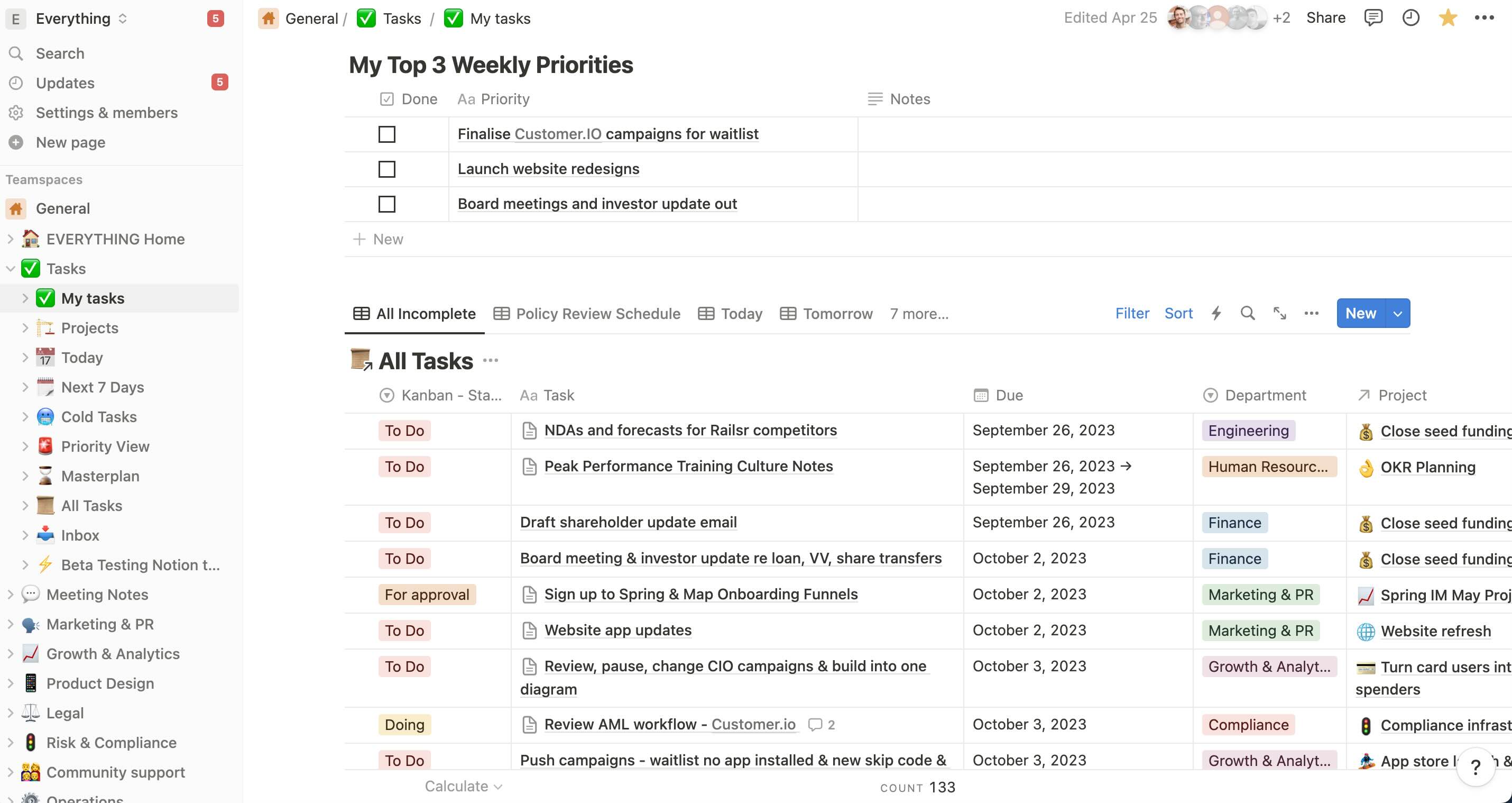
Building Operational Excellence from Day One
OKRs, Operations & Delivery
Months
From idea to FCA regulated app launch
Weeks Ahead
Weeks we launched ahead of OKR forecasted timeline
Team Growth
Team growth scaling without impacting operational clarity
"Speed of high quality execution was our superpower. While traditional fintechs took years to launch, we proved that with the right team and approach, you could go from idea to regulated app in under 8 months without compromising on quality or compliance.
"
The Challenge
Orchestrating chaos into clarity in a complex regulated space
Building a fintech startup targeting Gen Z required navigating multiple complex challenges: regulatory compliance with the FCA as an e-money distributor, coordinating across diverse functions (tech, product, ops, marketing, compliance, finance, community), and maintaining rapid execution velocity whilst scaling from concept to 40,000+ waitlist users. Without robust operational infrastructure and team alignment, these moving parts would have created bottlenecks that could have delayed our launch by months.
Cross-functional Coordination
With teams spanning tech, product, ops, marketing, compliance, finance and community across multiple time zones, we needed systems to ensure everyone understood dependencies, delivery timelines and shared in the vision
Regulatory Complexity
Operating as an FCA-regulated e-money distributor whilst partnering with the likes Mastercard and Railsr required meticulous tracking of compliance deliverables and and adherence to regulatory requirements
Rapid Scale Preparation
Growing from 3 to 18 team members meant building operational systems that could scale without breaking as we expanded across multiple functions and geographies.


The Strategy
OKRs meet masterplan: a unified approach to startup operations
I designed a comprehensive operational architecture in Notion, from scratch, that combined the goal-setting power of OKRs with detailed project management visibility. This wasn't just about tracking tasks. It was about creating organisational clarity where every team member could understand both their individual contribution and how it connected to our larger mission. The system integrated strategic planning, tactical execution, and performance measurement into a single source of truth.
Integrated OKR Architecture
Built bespoke OKR framework linking individual objectives to company-wide outcomes, ensuring every task contributed to measurable business impact
Company Masterplan Timeline
Created comprehensive project management system showing every task across all departments, enabling proactive identification of bottlenecks and dependencies
Rhythmic Review Cadence
Established weekly tactical reviews, monthly execution reviews and quarterly in-person strategic sessions review performance and reset priorities to maintain alignment and momentum
The Execution
From whiteboard to regulated launch in record time
The implementation followed a structured four-phase approach, each building upon the previous foundation. Rather than implementing everything at once, we prioritised the most critical operational elements first, then iteratively enhanced the system as our needs became more sophisticated. This allowed us to maintain operational excellence whilst moving at startup speed.
Foundation Architecture & OKR Framework Design
Building the foundational structure required translating high-level strategic objectives into measurable, actionable OKRs whilst designing a Notion workspace that could scale with our ambitions. I started by mapping our core strategic pillars (product development, regulatory compliance, user acquisition, fundraising) into a hierarchical OKR structure that cascaded from company level to individual contributor level. Critically this was done directly with each individual team member so we got bottom up and top down alignment on what needed to happen.
The challenge was creating a system sophisticated enough to handle the complexity of a regulated fintech whilst remaining intuitive for a rapidly growing team. I designed templates and workflows that enforced consistency whilst allowing flexibility for different functional areas to adapt the system to their specific needs.
"The foundation had to be bulletproof because everything else would be built on top of it. We didn't have time to rebuild our operational infrastructure mid-flight."

The Masterplan & Cross-functional Alignment
With the OKR foundation in place, I built the company masterplan, which a comprehensive timeline showing every task, social post, milestone, and dependency across all departments. This was far more than a project management tool; it was our operational crystal ball, allowing leadership to spot potential bottlenecks weeks before they could impact delivery but critically allowing the wider team deep understanding of what was happening outside of their lanes.
The masterplan integrated with our OKR architecture, showing how tactical tasks connected to strategic objectives. Team members could see not just what they needed to deliver, but why it mattered and how delays might impact other teams. This transparency dramatically reduced the coordination overhead typically associated with cross-functional projects.
"Visibility and autonomy breeds accountability. When everyone can see impact what they're focusing on and see how their work impacts others, the quality of execution naturally improves."

Meeting Rhythms & Communication Protocols
Operational excellence requires consistent communication rhythms. I established a multi-tiered meeting structure: daily 10 minute stand-ups unblocking any issues, weekly tactical reviews focused on immediate blockers and progress updates, monthly personal development catch-ups checking in on the human side, monthly half-day sessions for strategic pivots, bottlenecks and resource allocation, and quarterly in-person strategy sessions for longer-term planning and OKR re-alignment.
Each meeting type had specific agendas, outcomes, and follow-up protocols embedded in our Notion system. Weekly reviews used data dashboards showing real-time OKR progress, while monthly sessions included comprehensive performance analysis against our masterplan timeline. The quarterly sessions combined strategic review with team building, ensuring we maintained both operational excellence and cultural cohesion.
"Meetings without structure are time theft. Every gathering needed clear objectives and measurable outcomes."

Performance Measurement & Continuous Iteration
The final phase focused on creating feedback loops that enabled continuous improvement. I built automated dashboards showing real-time progress against OKRs, project timeline adherence, and team productivity metrics as well as individual dashboards based on what each team member felt helped them push the needle. We referred to them constantly and we had collective ownership of them. More importantly, I was open to better ways of doing things, made time for every voice, established protocols for systematically capturing lessons learned and incorporating them into process improvements and tweaking our ways of working.
The system evolved continuously based on user feedback and operational learnings. What started as a basic OKR tracking system became a comprehensive operational intelligence platform that informed everything from hiring decisions to product roadmap prioritisation. By launch, every team member knew exactly how their work contributed to our launch and were proud of it.
"The best operational systems learn and adapt. Static processes die the moment your startup grows beyond their original assumptions."

The Results
Operational excellence feeds extraordinary outcomes
The operational infrastructure delivered results that exceeded our most optimistic projections. We didn't just meet our ambitious timeline...we smashed it, launching a regulated app weeks ahead of our forecasts. Our investors were as shocked as they were impressed. More importantly, the system enabled sustainable growth, allowing us to scale from concept to begin to scale whilst maintaining operational excellence and having no costly compliance slip-ups.
Months
Concept to FCA-regulated app launch. The industry average is 18-24 months
Weeks Ahead
Number of weeks ahead of our forecasts we launched
Compliance Delays
Zero regulatory delays or compliance issues
Operational Delays
No critical path delays due to ops or coordination failures
Staff Satisfaction
The team owned the strategy and execution and it meant a lot to them
Waitlist Users
Users acquired through systematically executed growth strategy
Learnings & Reflections
Hard-won insights from building operations at startup speed
I may have cut my teeth in operations during my time at Crowdcube but here was where those lessons paid dividends. Building watertight operational infrastructure whilst executing at startup velocity is hard and a fine balance. How do you maintain consistency of approach and visibility without hindering autonomy and creativity. The answer is partly in building systems and processes that are directly beneficial and helpful to the end user, and a big part in involving them heavily in the building of them. Systems thinking and execution excellence aren't opposing forces. I believe they're multipliers. The investment in upfront operational design paid dividends throughout our journey, but the process wasn't without challenges. Some systems over-engineered early processes, while others required multiple iterations before finding the right balance between structure and flexibility.
Start Simple, Scale Systematically
My initial Notion architecture was overly complex, leading to adoption resistance. Operational systems must earn their complexity through proven value delivery. The most effective approach is launching simply, then adding sophistication based on demonstrated need
Culture Eats Process for Breakfast
Even the most elegant operational systems fail without cultural buy-in. My breakthrough came when I involved team leads in designing their functional area workflows, creating ownership rather than imposing solutions. Operational excellence requires collaborative design, not top-down mandates.
Real-time Adaptation Over Perfect Planning
30% of our original masterplan required revision as market conditions and regulatory requirements evolved . The greatest value wasn't perfect prediction but enabling rapid, informed adaptation when assumptions proved incorrect. Building systems that facilitated change rather than resisted it became a competitive advantage.